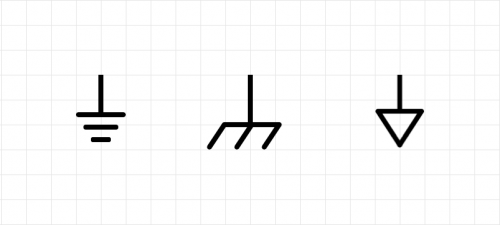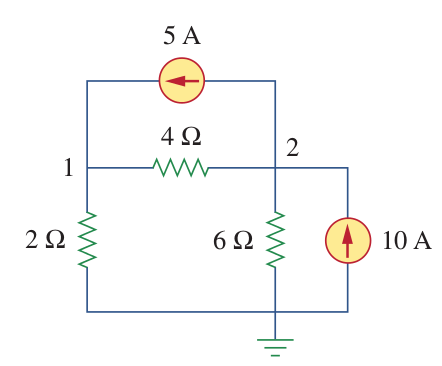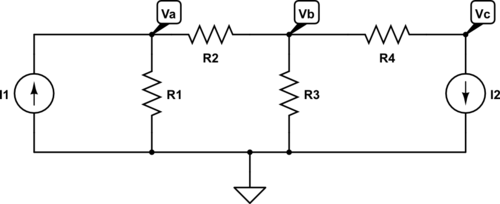Nodal Analysis
In the nodal analysis, node voltages are calculated by solving the Kirchhoff's Current Law (KCL) equations obtained from each node.
Method includes the following steps:
- Choose a reference node (ground)
- Label node voltages
- Write KCL equations for each node except the ground node.
(For reference check Nodal Analysis e-book).
1-Choose a reference node (or ground node)
- It is best to choose ground node as the node interconnects the most branches.
- The ground node is usually at the bottom of circuit.
- Label ground with one of the symbols below:

2-Assign node voltages
Give label to each node except the reference node.
3- Write KCL equations
- write KCL equations (the most practical way is to use negative sign for the currents entering to the node), positive sign for currents exiting from the node).
- After defining KCL for each node, the equations can be put in matrix form and the problem can be solved.
4-Solve
Methods for solving system of linear equations:
- Elimination Method : Simplest but not really scalable to more complex equations
- Row reduction: A systematical way of elimination, can be applied to more complex cases, but it's time consuming.
- Cramer's Rule (example): Practical for up to 3x3 matrices.
- Inverse Matrix Method: Scalable to even the most complex cases, but you'll need a calculator or computer.
Example 1:
Calculate the node voltages for the following circuit1:

1. Alexander&Sadiku, 2012, pg84. ↩

Answer: V1= 40/3 V, V2= 20 V
Matrix Equations
Example:
Apply the nodal analysis in the following circuit: This is some text.

- Define the bottom node as the reference node
- Apply KCL for each node:

Node a:
Node b:
Node c:
Then everything can be put into matrix form:
which is equivalent to
For convenience instead of resistance, conductance can also be used:
Thus, the equation becomes:
Note that, this is a classic matrix equation:
This equation can be solved as:
where \(A^{-1}\) is the inverse of matrix A. In order to get the inverse of a matrix it has to be a square matrix. Furthermore, due to KCL applied A matrix in an electric circuit will be symmetrical.